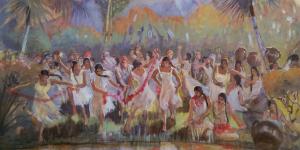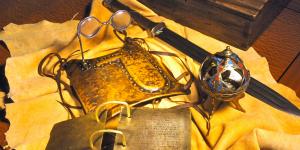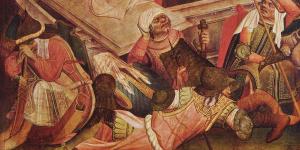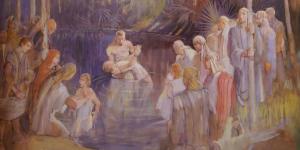You are here
Book of Mormon Central is in the process of migrating to our new Scripture Central website.
We ask for your patience during this transition. Over the coming weeks, all pages of bookofmormoncentral.org will be redirected to their corresponding page on scripturecentral.org, resulting in minimal disruption.
Gospel Doctrine Lesson #19: None Could Deliver Them But the Lord

Scripture Block
Mosiah 18-24
Baptism is a sign that a person has is willing to enter into a covenant with God. The covenant includes a promise to join the fold of God, share the burdens of others, and stand as a witness of God.
Lesson Manual
KnoWhys
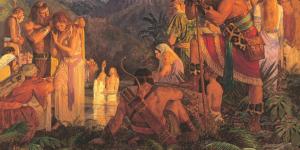
At Baptism, What Do We Covenant to Do?
Mosiah 18:10
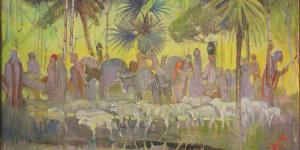
How Does the Lord Make our Burdens Light?
Mosiah 24:15
Featured Visuals
Video: Discussions on the Book of Mormon: Moriah 18-24. Available at BYUtv.org
Professors from the BYU Department of Ancient Scripture discuss Mosiah chapters 18 thru 24 and the history and doctrine found therein, including Ammon's ministry to the Lamanites and King Lamoni's conversion.
This is Scripture Roundtable 163 from The Interpreter Foundation, in which we discuss the Book of Mormon Gospel Doctrine Lesson #19, None Could Deliver Them but the Lord, focusing on scriptures in Mosiah 18-24, bringing in various insights to help us better understand the scriptures. These roundtables will generally follow the 2016 Gospel Doctrine schedule of scriptures, a few weeks ahead of time.
Articles
The Baptismal Covenant: Mosiah 18
"Understanding Christian Baptism Through the Book of Mormon," by Noel B. Reynolds in BYU Studies Quarterly 51, no. 2.
Early Christianity saw a wide proliferation of theories and practices concerning baptism, and now many Christians, including Mormons, commonly understand it as a means to repent and wash away one's sins. But the Book of Mormon prophets taught that baptism is a covenant and a witnessing to God that one has already repented and commits to follow Jesus Christ, and that sins are remitted by the Holy Ghost.
"What Is the Purpose of Baptism in the Book of Mormon?(link is external)" by Book of Mormon Central KnoWhy 59
The New Testament teaches that baptism is essential for entrance into the kingdom of God. The Book of Mormon teaches that baptism is a symbol of a covenant that one makes with God. This KnoWhy discusses baptism’s place in the doctrine of Christ.
King Noah, Limhi, Battle, and Bondage: Mosiah 19-24
"Marriage and Treaty in the Book of Mormon: The Case of the Abducted Lamante Daughters(link is external)," by S. Kent Brown in From Jerusalem to Zarahemla: Literary and Historical Studies of the Book of Mormon(link is external).
Biblical law and custom must have persisted among Book of Mormon peoples. The account of the abducted Lamanite women offers an unusually clear view into legal and social norms among Nephites. Perhaps surprisingly, the report hints strongly that some of these norms also survived among Lamanites.
"Dancing Maidens and the Fifteenth of Av(link is external)," by John W. Welch in Reexploring the Book of Mormon(link is external).
In Mosiah 20, the wicked priests of King Noah find the Lamanite daughters dancing and take them to wife. When looked at from an ancient Israelite perspective, one discovers that before the Babylonian captivity, the fifteenth of Av was a time of mating and "bride hunting," where the young maidens would dance, as Israelite men chose wives. If that is the setting of this story, it makes more sense why the priests took the maidens to wife and why the Lamanite daughters had apparently no protestations.
"Deliverance from Bondage,"(link is external) by Clyde J. Williams in The Book of Mormon: Mosiah, Salvation Only Through Christ (link is external)
Williams provides thorough and thoughtful commentary on the story of the escape of Limhi's people from bondage in Mosiah 19-24. He first details the steps that Limhi and his people took that led to their eventual bondage to the Lamanites. He then likens the types of spiritual bondage that we can find ourselves in if we follow Limhi's pattern. Williams concludes his commentary by showing that it was ultimately by humbling themselves before the Lord that Limhi and his people were able to escape from the bondage of the Lamanites.
"Benjamin or Mosiah? An Anomaly in Mosiah 21:28(link is external)," by L. Ara Norwood, Fair Mormon 2001 Conference
In Mosiah 21:28, it reads that Mosiah had a marvelous gift of seership. However, in the Printer’s Manuscript and the 1830 edition of the Book of Mormon, it reads that Benjamin was the one with the gift of seership. Also in Ether 4:1, this textual change from Benjamin to Mosiah occurs. Norwood outlines the anti-Mormon reactions to this textual change, outlines previous LDS explanations for such a change, and then provides his own explanation that can still leave room for faith. See also Royal Skousen on this point: “Despite the apparent difficulties with the original reading, the critical text will restore the name Benjamin in Mosiah 21:28 and Ether 4:1; the occurrence of Benjamin instead of Mosiah cannot be readily explained as an error in the early transmission of the text; moreover, the text can be interpreted so that Benjamin was still alive when the plates of Ether were delivered by king Limhi to king Mosiah, who then gave the Jaredite record to his father, king Benjamin, for his examination and perhaps safekeeping.” Royal Skousen, Analysis of Textual Variants of the Book of Mormon, Part Three, Mosiah 17-Alma 20, pages 1420-1421.
"Priesthood in Mosiah(link is external)," by Daniel C. Peterson in The Book of Mormon: Mosiah, Salvation Only Through Christ(link is external)
Daniel Peterson examines the different uses of priesthood in the Book of Mormon, from its use in family circles to its function in government and in the temple cult. In Nephite society, government and religion were often combined into one when the king was concurrently regarded as priest and mouthpiece for God. Peterson also discusses the issue of the absence of the Levitical priesthood in the Americas. Peterson concludes that the Nephites had an order of the priesthood that was ordained of God and this was likely the Melchizedek priesthood.
"Authority in the Book of Mosiah(link is external)," by Daniel C. Peterson in The FARMS Review 18, no. 1 (2006).(link is external)
In a similar article, Daniel Peterson again attacks the issue of priesthood in the Book of Mormon. He discusses its usage in the small plates, particularly in the book of Mosiah. He defines what the role of priests were in the Book of Mormon, how they were ordained, the organization of the church in the book of Mosiah, and priestly kingship.
"Another Testament of Jesus Christ: Mormon's Poetics(link is external)," by Heather Hardy in Journal of Book of Mormon Studies 16, no. 2 (2007).(link is external)
The Book of Mormon emphatically testifies of Jesus Christ, but the Book of Mormon doesn't just convince nonbelievers of the divinity of Jesus Christ. The Book of Mormon also acts as an additional guidebook for spiritual growth for the believer. Hardy outlines various parallelisms and chiasms found in the text to emphasize Mormon's point of creating a deeply complex and nuanced guidebook for living the gospel.

